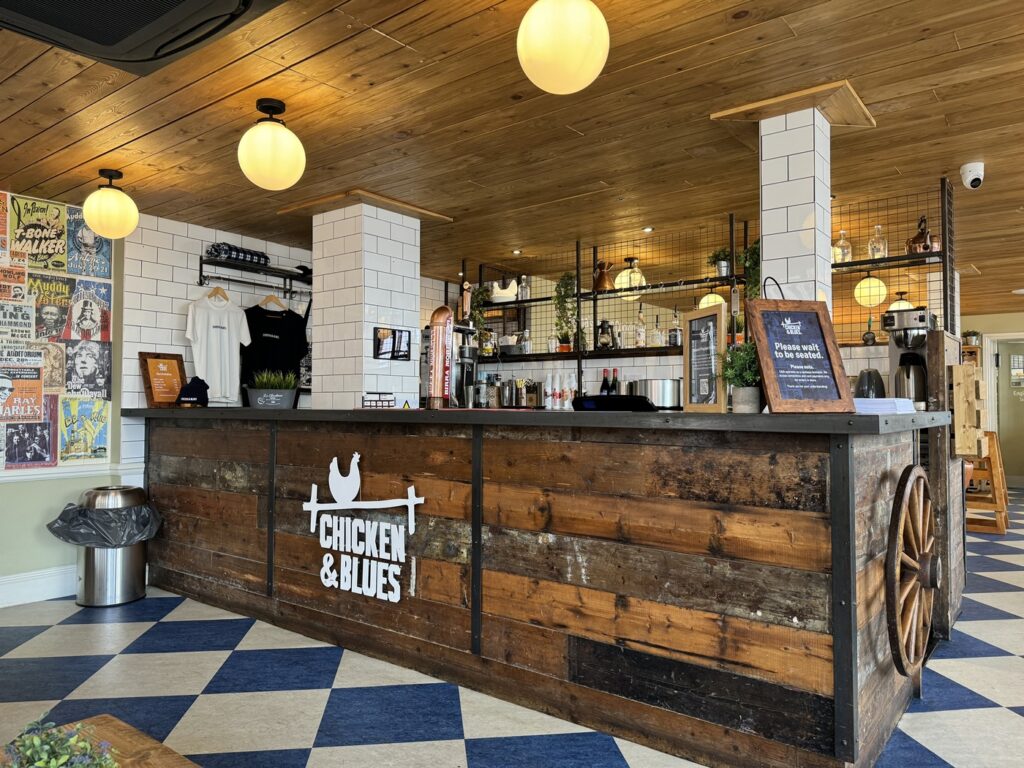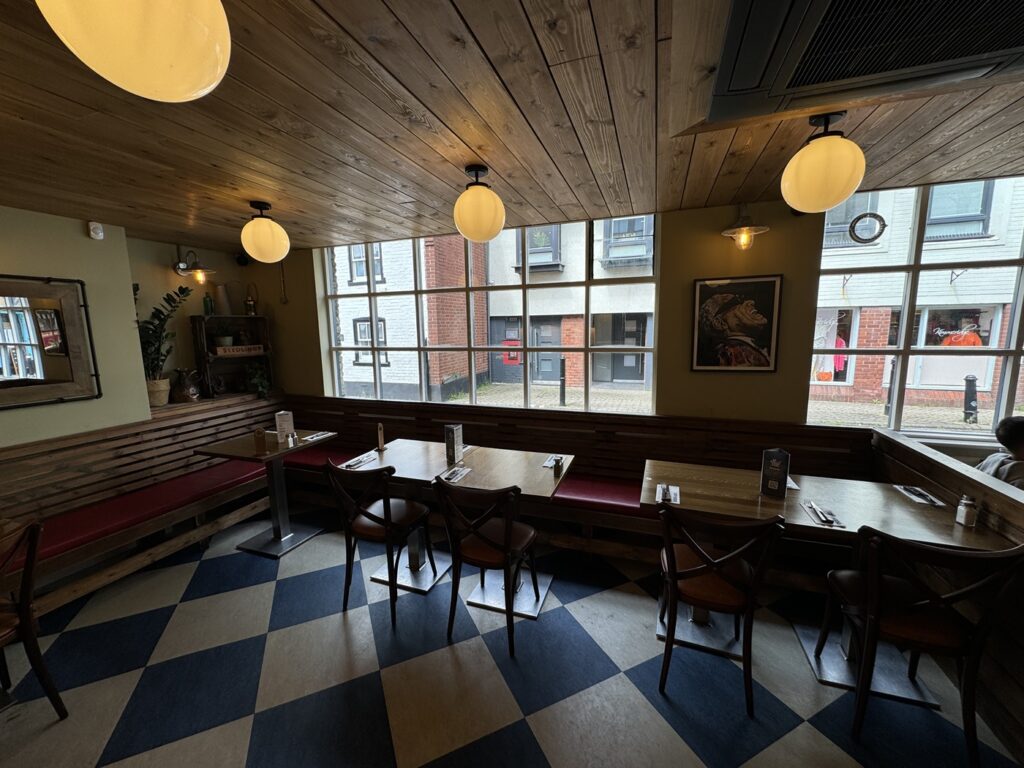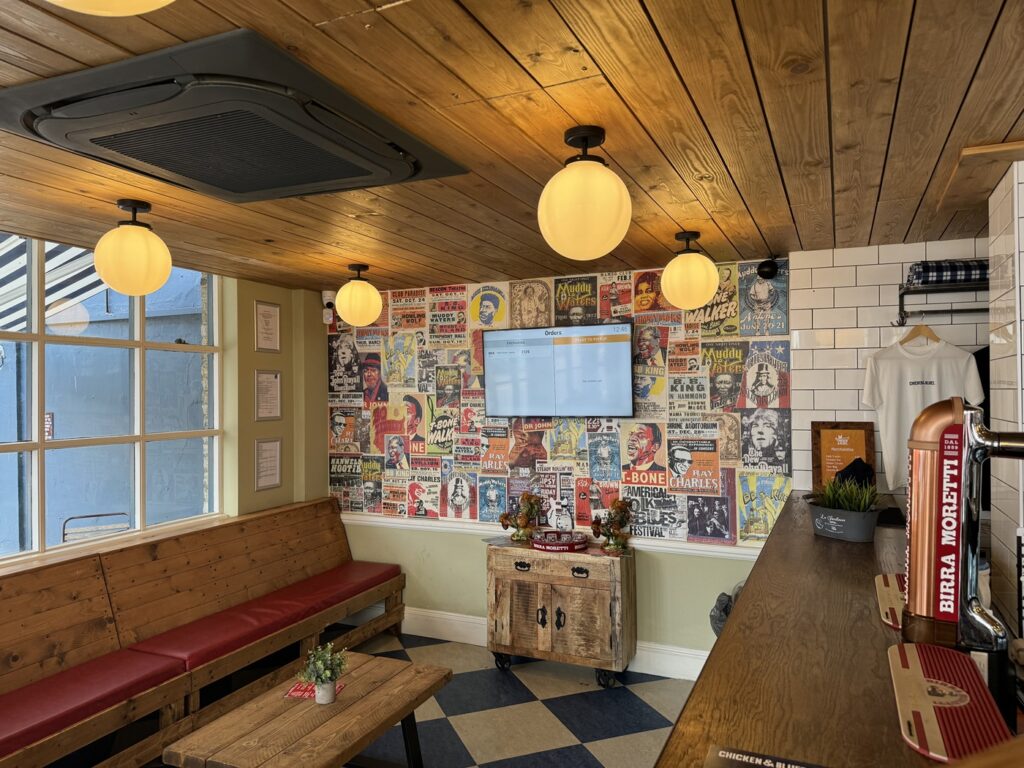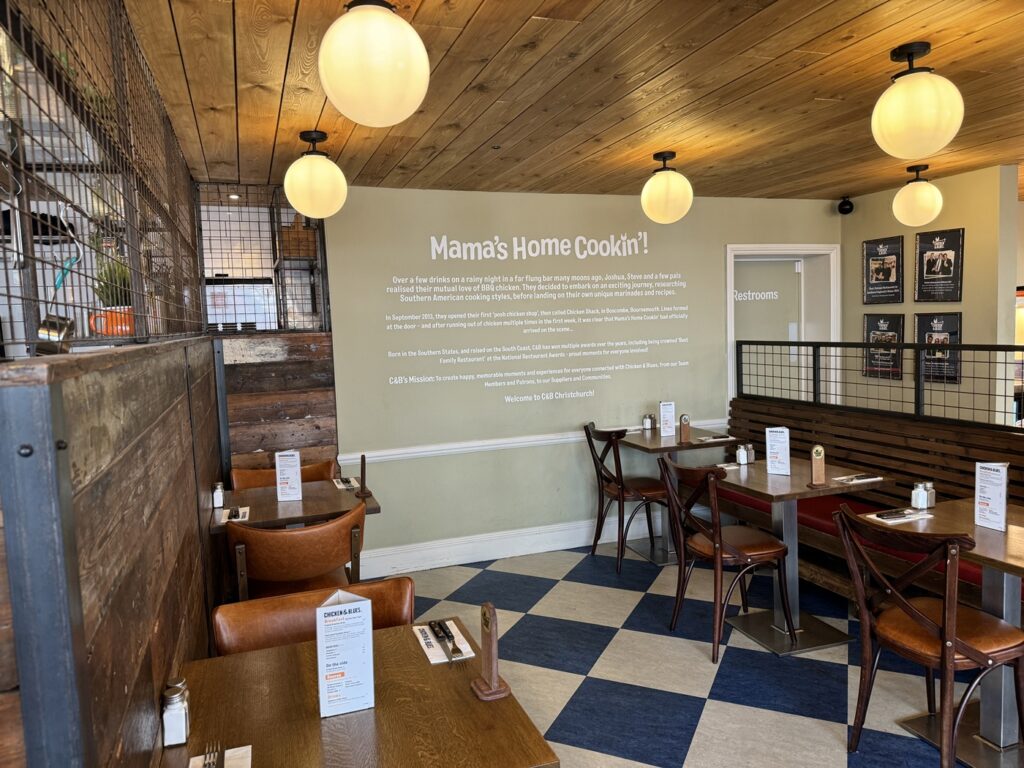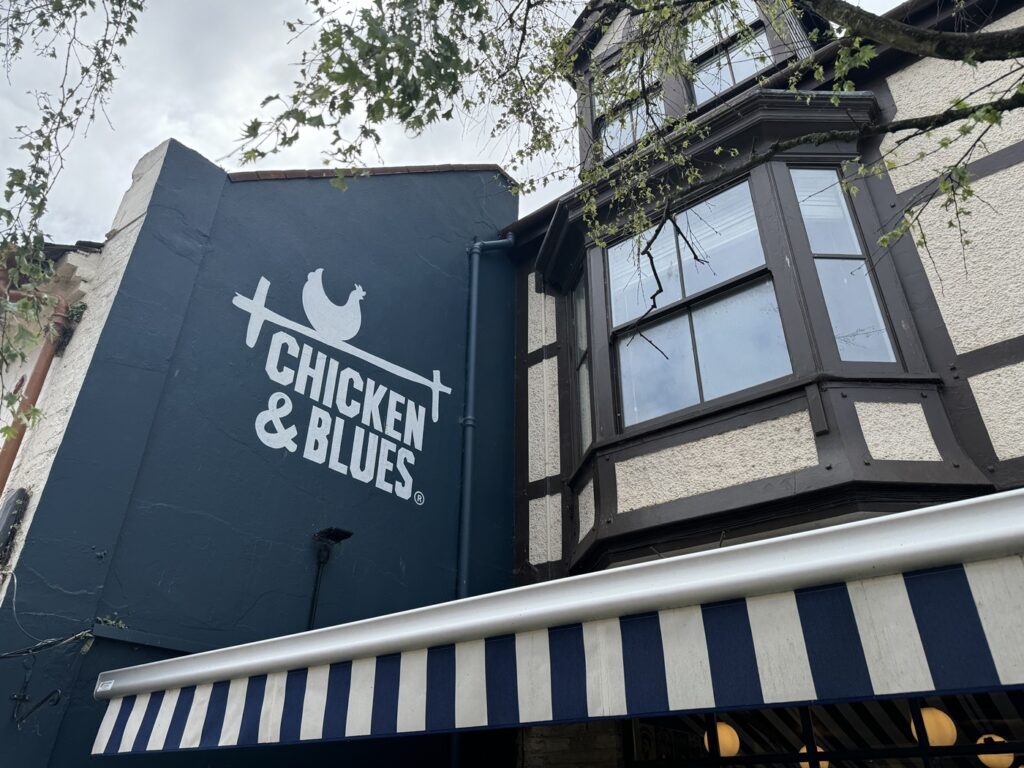UK
{{filters.projectType['Array']}}
Back
Chicken & Blues
array(24) {
["id"]=>
int(14815)
["name"]=>
string(15) "Chicken & Blues"
["slug"]=>
string(13) "chicken-blues"
["challenge"]=>
string(1125) "The primary objective of the Chicken & Blues project was to implement an automated lighting and audio system that would enhance the customer experience in the restaurant. This system aimed to create a consistent and enjoyable ambiance, while also reducing the workload and potential for human error among the staff.
The scope of the project encompassed all aspects of the electrical and automation systems within the restaurant. This included the design, installation, and integration of automated lighting and audio controls that could be easily managed and adapted to different settings and times of the day.
Several challenges were encountered during the project:
- Ensuring Consistency: Developing a system that could maintain a consistent customer experience every day, regardless of staff changes or other variables.
- Minimizing Human Error: Designing the system to be intuitive and foolproof, reducing the likelihood of operational errors by the staff.
- Energy Efficiency: Balancing the need for an inviting ambiance with the goal of keeping energy consumption low."
["solution"]=>
string(3452) "The project utilized the Loxone automation system, chosen for its robust capabilities and flexibility in managing complex lighting and audio setups. Loxone provided the necessary tools to create an energy-efficient, easily manageable system that could be tailored to the specific needs of the restaurant.
Methodology:
1. Client Consultation: The project began with thorough consultations with the restaurant owners to understand their vision and specific requirements. This involved multiple meetings to gather detailed information about their desired customer experience and operational goals.
2. Planning: Based on the insights gained from the consultations, a comprehensive plan was developed. This plan included designing an automation system that was both user-friendly and capable of delivering the desired ambiance. Key considerations included energy efficiency, ease-of-use, and the ability to adapt to different scenarios (e.g., day vs. night settings, special events).
3. Execution: The execution phase was broken down into several stages:
- Design Phase: Creation of detailed schematics and blueprints for the automated system, ensuring all technical and aesthetic requirements were met.
- Installation Phase: Systematic installation of the Loxone automation system, including wiring, sensor placement, and integration with existing electrical infrastructure.
- Testing Phase: Rigorous testing to ensure all components functioned correctly and as intended. This included stress testing under various conditions to guarantee reliability and performance.
- Commissioning Phase: Final adjustments and fine-tuning based on feedback from the client and initial user experience. Staff training was also conducted to ensure they could operate the system effectively.
Results:
The project successfully delivered an automated lighting and audio system that was:
- Adaptable: Easily adjustable settings allowed for quick changes to suit different times of day or special events.
- User-friendly: The system's intuitive interface ensured that staff could operate it with minimal training, reducing the risk of errors.
- Energy-efficient: Smart automation and efficient design led to significant energy savings, aligning with the restaurant's sustainability goals.
Impact:
The automation system had a significant positive impact on the restaurant's operations and customer experience. By automating routine tasks, staff could focus more on providing excellent service. The consistent and appealing ambiance created by the automated system enhanced the overall dining experience, leading to higher customer satisfaction.
Team Involvement:
The entire Fayer team played crucial roles throughout the project. Team members were involved in various stages, including:
- Organizing: Coordinating meetings, timelines, and resources.
- Designing: Developing the system architecture and user interface.
- Installing: Carrying out the physical installation and integration of the system.
- Commissioning: Conducting final testing, adjustments, and staff training.
Duration:
The project was completed over an 8-week period. This timeline included initial consultations, planning, installation, testing, and final commissioning."
["partner_quote"]=>
string(0) ""
["partner_quote_name"]=>
string(0) ""
["partner_quote_position"]=>
string(0) ""
["more_info_url"]=>
string(0) ""
["preview_image"]=>
string(90) "https://portal.loxone.com/admin/wp-content/uploads/2024/05/ChickenBlues-use-C-768x576.jpeg"
["application_areas"]=>
array(2) {
[0]=>
string(8) "lighting"
[1]=>
string(10) "multimedia"
}
["tags"]=>
array(0) {
}
["project_type"]=>
array(2) {
[0]=>
string(11) "hospitality"
[1]=>
string(8) "retrofit"
}
["copyright"]=>
NULL
["images"]=>
array(7) {
[0]=>
array(2) {
["image"]=>
string(91) "https://portal.loxone.com/admin/wp-content/uploads/2024/05/ChickenBlues-use-C-1024x768.jpeg"
["copyright"]=>
string(0) ""
}
[1]=>
array(2) {
["image"]=>
string(93) "https://portal.loxone.com/admin/wp-content/uploads/2024/05/ChickenBlues-use-6-C-1024x768.jpeg"
["copyright"]=>
string(0) ""
}
[2]=>
array(2) {
["image"]=>
string(93) "https://portal.loxone.com/admin/wp-content/uploads/2024/05/ChickenBlues-use-3-C-1024x768.jpeg"
["copyright"]=>
string(0) ""
}
[3]=>
array(2) {
["image"]=>
string(93) "https://portal.loxone.com/admin/wp-content/uploads/2024/05/ChickenBlues-use-4-C-1024x768.jpeg"
["copyright"]=>
string(0) ""
}
[4]=>
array(2) {
["image"]=>
string(93) "https://portal.loxone.com/admin/wp-content/uploads/2024/05/ChickenBlues-use-2-C-1024x768.jpeg"
["copyright"]=>
string(0) ""
}
[5]=>
array(2) {
["image"]=>
string(93) "https://portal.loxone.com/admin/wp-content/uploads/2024/05/ChickenBlues-use-7-C-1024x768.jpeg"
["copyright"]=>
string(0) ""
}
[6]=>
array(2) {
["image"]=>
string(93) "https://portal.loxone.com/admin/wp-content/uploads/2024/05/ChickenBlues-use-8-C-1024x768.jpeg"
["copyright"]=>
string(0) ""
}
}
["country"]=>
string(2) "UK"
["city"]=>
string(12) "Christchurch"
["build_year"]=>
string(4) "2023"
["square_meters"]=>
string(0) ""
["account_data"]=>
array(4) {
["id"]=>
string(36) "d6da3213-1f42-4ce6-b452-2f21184321db"
["name"]=>
string(9) "Fayer Ltd"
["website"]=>
string(22) "http://fayerltd.co.uk/"
["partner_website"]=>
string(35) "/partner/BH10 6JG-dorset/fayer-ltd/"
}
["conference"]=>
string(4) "none"
["products"]=>
array(4) {
[0]=>
array(2) {
["sku"]=>
string(6) "100512"
["name"]=>
string(18) "Miniserver Compact"
}
[1]=>
array(2) {
["sku"]=>
string(6) "100029"
["name"]=>
string(16) "Dimmer Extension"
}
[2]=>
array(2) {
["sku"]=>
string(6) "100429"
["name"]=>
string(16) "Stereo Extension"
}
[3]=>
array(2) {
["sku"]=>
string(6) "100221"
["name"]=>
string(16) "Touch Tree White"
}
}
["video"]=>
string(0) ""
["fallback"]=>
array(8) {
["name"]=>
string(15) "Chicken & Blues"
["challenge"]=>
string(1125) "The primary objective of the Chicken & Blues project was to implement an automated lighting and audio system that would enhance the customer experience in the restaurant. This system aimed to create a consistent and enjoyable ambiance, while also reducing the workload and potential for human error among the staff.
The scope of the project encompassed all aspects of the electrical and automation systems within the restaurant. This included the design, installation, and integration of automated lighting and audio controls that could be easily managed and adapted to different settings and times of the day.
Several challenges were encountered during the project:
- Ensuring Consistency: Developing a system that could maintain a consistent customer experience every day, regardless of staff changes or other variables.
- Minimizing Human Error: Designing the system to be intuitive and foolproof, reducing the likelihood of operational errors by the staff.
- Energy Efficiency: Balancing the need for an inviting ambiance with the goal of keeping energy consumption low."
["solution"]=>
string(3452) "The project utilized the Loxone automation system, chosen for its robust capabilities and flexibility in managing complex lighting and audio setups. Loxone provided the necessary tools to create an energy-efficient, easily manageable system that could be tailored to the specific needs of the restaurant.
Methodology:
1. Client Consultation: The project began with thorough consultations with the restaurant owners to understand their vision and specific requirements. This involved multiple meetings to gather detailed information about their desired customer experience and operational goals.
2. Planning: Based on the insights gained from the consultations, a comprehensive plan was developed. This plan included designing an automation system that was both user-friendly and capable of delivering the desired ambiance. Key considerations included energy efficiency, ease-of-use, and the ability to adapt to different scenarios (e.g., day vs. night settings, special events).
3. Execution: The execution phase was broken down into several stages:
- Design Phase: Creation of detailed schematics and blueprints for the automated system, ensuring all technical and aesthetic requirements were met.
- Installation Phase: Systematic installation of the Loxone automation system, including wiring, sensor placement, and integration with existing electrical infrastructure.
- Testing Phase: Rigorous testing to ensure all components functioned correctly and as intended. This included stress testing under various conditions to guarantee reliability and performance.
- Commissioning Phase: Final adjustments and fine-tuning based on feedback from the client and initial user experience. Staff training was also conducted to ensure they could operate the system effectively.
Results:
The project successfully delivered an automated lighting and audio system that was:
- Adaptable: Easily adjustable settings allowed for quick changes to suit different times of day or special events.
- User-friendly: The system's intuitive interface ensured that staff could operate it with minimal training, reducing the risk of errors.
- Energy-efficient: Smart automation and efficient design led to significant energy savings, aligning with the restaurant's sustainability goals.
Impact:
The automation system had a significant positive impact on the restaurant's operations and customer experience. By automating routine tasks, staff could focus more on providing excellent service. The consistent and appealing ambiance created by the automated system enhanced the overall dining experience, leading to higher customer satisfaction.
Team Involvement:
The entire Fayer team played crucial roles throughout the project. Team members were involved in various stages, including:
- Organizing: Coordinating meetings, timelines, and resources.
- Designing: Developing the system architecture and user interface.
- Installing: Carrying out the physical installation and integration of the system.
- Commissioning: Conducting final testing, adjustments, and staff training.
Duration:
The project was completed over an 8-week period. This timeline included initial consultations, planning, installation, testing, and final commissioning."
["partner_quote"]=>
string(0) ""
["partner_quote_name"]=>
string(0) ""
["partner_quote_position"]=>
string(0) ""
["more_info_url"]=>
string(0) ""
["video"]=>
string(0) ""
}
}
Fact Check
Country
{{getRegion('UK')}}
Challenge
The primary objective of the Chicken & Blues project was to implement an automated lighting and audio system that would enhance the customer experience in the restaurant. This system aimed to create a consistent and enjoyable ambiance, while also reducing the workload and potential for human error among the staff.
The scope of the project encompassed all aspects of the electrical and automation systems within the restaurant. This included the design, installation, and integration of automated lighting and audio controls that could be easily managed and adapted to different settings and times of the day.
Several challenges were encountered during the project:
- Ensuring Consistency: Developing a system that could maintain a consistent customer experience every day, regardless of staff changes or other variables.
- Minimizing Human Error: Designing the system to be intuitive and foolproof, reducing the likelihood of operational errors by the staff.
- Energy Efficiency: Balancing the need for an inviting ambiance with the goal of keeping energy consumption low.Solution
The project utilized the Loxone automation system, chosen for its robust capabilities and flexibility in managing complex lighting and audio setups. Loxone provided the necessary tools to create an energy-efficient, easily manageable system that could be tailored to the specific needs of the restaurant.
Methodology:
1. Client Consultation: The project began with thorough consultations with the restaurant owners to understand their vision and specific requirements. This involved multiple meetings to gather detailed information about their desired customer experience and operational goals.
2. Planning: Based on the insights gained from the consultations, a comprehensive plan was developed. This plan included designing an automation system that was both user-friendly and capable of delivering the desired ambiance. Key considerations included energy efficiency, ease-of-use, and the ability to adapt to different scenarios (e.g., day vs. night settings, special events).
3. Execution: The execution phase was broken down into several stages:
- Design Phase: Creation of detailed schematics and blueprints for the automated system, ensuring all technical and aesthetic requirements were met.
- Installation Phase: Systematic installation of the Loxone automation system, including wiring, sensor placement, and integration with existing electrical infrastructure.
- Testing Phase: Rigorous testing to ensure all components functioned correctly and as intended. This included stress testing under various conditions to guarantee reliability and performance.
- Commissioning Phase: Final adjustments and fine-tuning based on feedback from the client and initial user experience. Staff training was also conducted to ensure they could operate the system effectively.
Results:
The project successfully delivered an automated lighting and audio system that was:
- Adaptable: Easily adjustable settings allowed for quick changes to suit different times of day or special events.
- User-friendly: The system's intuitive interface ensured that staff could operate it with minimal training, reducing the risk of errors.
- Energy-efficient: Smart automation and efficient design led to significant energy savings, aligning with the restaurant's sustainability goals.
Impact:
The automation system had a significant positive impact on the restaurant's operations and customer experience. By automating routine tasks, staff could focus more on providing excellent service. The consistent and appealing ambiance created by the automated system enhanced the overall dining experience, leading to higher customer satisfaction.
Team Involvement:
The entire Fayer team played crucial roles throughout the project. Team members were involved in various stages, including:
- Organizing: Coordinating meetings, timelines, and resources.
- Designing: Developing the system architecture and user interface.
- Installing: Carrying out the physical installation and integration of the system.
- Commissioning: Conducting final testing, adjustments, and staff training.
Duration:
The project was completed over an 8-week period. This timeline included initial consultations, planning, installation, testing, and final commissioning.
